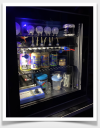I learned of DIY fresh food feeders first through Scott Sweet’s fresh food auto-feeder design. Where the Scott Sweet Feeder uses 1/2” rigid plumbing and similarly scaled components for a continuously flowing system, I went minimalist in construction and with low water flow.
I started sourcing parts summer ‘20, sketching, prototyping and testing in October and November, and began running the system Thanksgiving weekend 2020.
The system cost me less than $250 to build using all new parts. Food not included.
Design
The fresh food auto-feeder uses 1/4” flexible waterline, push fittings, Neptune PMUP, and peristaltic dosing meter to transfer fresh food from refrigerated bottles to the tank. While Neptune Apex and PMUP are used in this version, any low flow timer-activated pump will work just as effectively.
Goals
- Easily sourced from inexpensive and common parts;
- Easily built using simple tools;
- Reliable low-risk continuous performance;
- Easy to maintain with self-flushing manifold.
How it works
In a small refrigerator
With the dosing pump’s clock and circulation pump’s timer in-synch,1.5 minutes after the dosing pump deposits fresh food into the manifold, a Neptune Apex PMUP in the return chamber of the sump (any similarly sized timer-activated pump for non-Apex systems) turns on for 30 seconds; the time needed to circulate tank water through the 40 ft loop. The pump, placed in the return chamber of the sump and attached to a 1/4” waterline, cycles water from the sump, through the refrigerator and manifold, and back to the mouth of the return pump in sump’s return chamber.
A dosed portion of food, as a result, moves from the refrigerator, is injected into the mouth of the return pump, then arrives in the display tank.
On the next hour, and every hour 24-times throughout the day regardless of feeding or not, the water cycle repeats for 30 seconds clearing the line of any food that might not have made it to the tank on the feed cycle.
In addition to the dosing pump depositing food, there is a manual port for injecting larger food using a syringe. I use this port for feeding thawed frozen food that the dosing pump would smash to mush. I keep 1-2 days of thawed mysis shrimp at hand in a container in the fridge, squeeze 2ml of shrimp into the port using a syringe, and follow-up with 10ml of fresh salt water to clear the port and push food into the manifold.
Outcomes
Since Thanksgiving 2020, the system has delivered more than 500 mL of Reef Nutrition food (approximately 8 mL/day total) including: Oyster Feast, Roti Feast, and Photo Feast. In addition to the dosed bottled foods, I manually inject into a feeder line frozen mysis shrimp (after thawing, 2 mL) and baby brine shrimp (0.5 mL). For the last two months, to Feb 6, 2021, I have used three of the four dosing heads and food sources.
There have been zero leaks. No indication of blockages or residue. And there is zero reverse water flow back into the food bottles. I credit this with a low-pressure pump that’s just powerful enough to push the food to the tank.
In terms of nutrients (NO3 and PO4), there has been -20% downswing of nitrate (15 to 12 ppm) and a 66% uptick in phosphate (0.03 to 0.05) since starting the system. I’m not drawing any conclusions of the cause of change; there are many other factors at play. It’s relatively stable with no visible adverse changes to the tank.
If I could do it again
If there were anything I’d do differently, I’d go with a bigger fridge. Although everything perfectly fits in this refrigerator and with room for large bottles, there is not a whole lot of space for moving things or reprogramming the dosing pump. For my use though, it is set-it and forget-it. If you think you might want to swap things out or change things up you might want a larger refrigerator.
Upgrades coming next
I am adding an unrefrigerated dosing unit for four more additives. I am going to create a second manifold like the one above and connect it to the water line. And I added RedSea Reef Energy Coral Food to the lineup.
Materials and Cost: $250-$400 total
FRIGIDAIRE EFMIS164 70 Can, Glass Door Beverage Center Refrigerator (a "used" returned purchase from Amazon) $98 (I scored a “used” one for $98)
Whynter BR-062WS Refrigerator $180
Kuppet 62-Can Refrigerator $150
Frigidaire 70 Can Beverage Refrigerator $125
Auto dosing pump, bottled fresh food, and food supply manifold are connected, chilled, and contained inside the refrigerator. The supply line enters and exits the fridge through drilled holes and connects to the food supply manifold using a 1/4” ’T’ press fitting. Any refrigerator will work.
Jebao Programmable Auto Dosing Pump 4-Head $60
Sits in the refrigerator. Each source in-flow line is inserted into refrigerated fresh food container. Each dosing out-flow line is connected to a manifold T push fitting. Any dosing pump that fits in fridge will work.
Manifold $10 (purchased in bulk from Amazon)
Series of T push fittings, one per container of live food. Each T-fitting connects to one of the dosing pump head’s out-flow lines. The manifold is attached to the closed-loop from and to the sump.
Neptune PMUP $40
Waterline and push fittings $20
40 ft 1/4” waterline
manifold parts: 1 T-fitting per food container ending at a T-fitting that the closed-loop passes though; 1/4” press-end cap
Attachments
Last edited:


